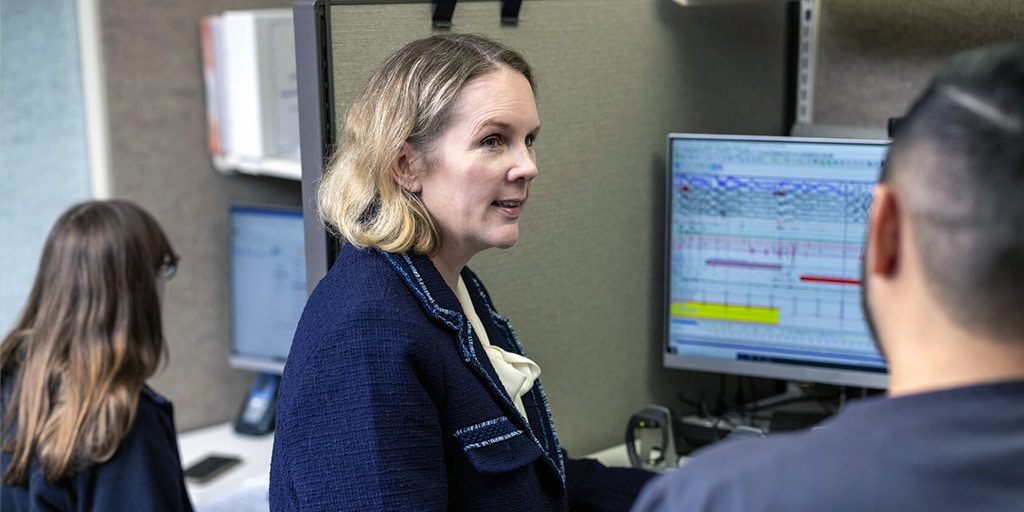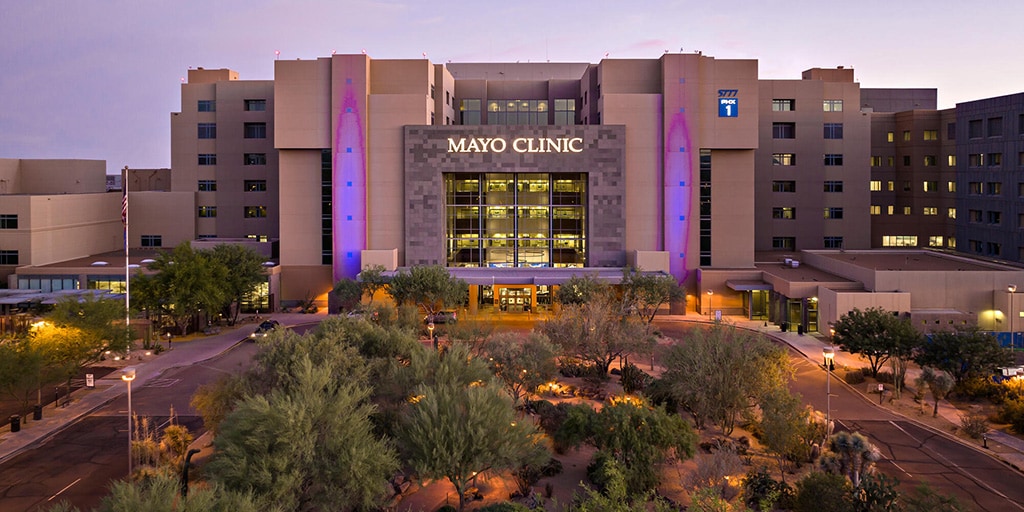Curriculum

Clinical training
The training for Mayo Clinic’s Sleep Medicine Fellowship consists of 12 blocks of clinical training. Each block is four or five weeks. In addition, there is a weekly continuity clinic day, complemented by ongoing didactics, research opportunities, and quality improvement projects.
As a fellow, you will explore:
- Sleep disordered breathing
- Insomnia
- Restless leg syndrome
- Narcolepsy
- Circadian rhythm disorders
- Parasomnias
There is a 9:1 faculty-to-trainee ratio and the fellow has formal career and research mentor assignments with a semi-annual assessment of goal progress.
Rotation schedule
| Rotation | Length |
|---|---|
| Orientation | 1 week |
| Adult sleep center | 33 weeks |
| Pediatric sleep center | 7 weeks |
| Adult sleep scoring | 2 weeks |
| Otorhinolaryngology | 2 weeks |
| Neurology movement disorders | 1 week |
| Electives | 4 weeks |
| Research | 2 weeks |
Rotation descriptions
- Adult sleep center: Develop competence in evaluating, diagnosing, and comprehensively treating patients over the entire spectrum of adult sleep and circadian rhythm disorders.
- Pediatric sleep center: Learn how to treat pediatric patients with sleep disorders and sleep-related breathing disorders.
- Adult sleep scoring: Develop competence in scoring sleep stages, respiratory, movement, and arousal events in polysomnography.
- Otorhinolaryngology: Fellows will work with otorhinolaryngologists to understand the surgical approaches offered for the treatment of snoring and obstructive sleep apnea syndrome. They will also learn how to examine the nose and pharynx in patients with sleep-disordered breathing.
- Neurology movement disorders: Become proficient in the clinical evaluation of patients with movement disorders.
- Electives: The electives available are sleep dentistry, behavior therapy, and hospital inpatient sleep service. These can vary in duration from one to two weeks.
- Research: Dedicated time to research projects.

Electives
The electives available are sleep dentistry, behavior therapy, and hospital inpatient sleep service. These can vary in duration from one to two weeks. There are four weeks of elective time available.
Didactic training
There is teaching time daily and weekly grand rounds. There is an additional conference at least once a week, such as the monthly clinical case conference, research conference, morbidity and mortality conference, and journal club.
All sleep medicine fellows participate in all didactic teaching sessions, clinical case conferences, journal clubs, research conferences, morbidity and mortality, and quality improvement conferences.
Conferences
Conferences are scheduled during times when patients are not scheduled.
- Internal medicine grand rounds: Weekly didactics cover a broad range of topics that are of interest to the sleep medicine provider.
- Sleep journal club: This is a monthly journal club where the sleep medicine fellow collaborates with a faculty member each month to present findings from an article.
- Research conference: This is a monthly conference to discuss research findings.
- M&M/QI conference: This is a monthly conference to discuss a morbidity and mortality case and discuss opportunities for quality improvement.
- Pulmonary case conference: This is a conference that occurs twice a month and includes all pulmonary and sleep medicine faculty and fellows to discuss an interesting case.
- Tri-site sleep conference: This is a monthly webcast case conference/journal club that includes the sleep medicine faculty and fellows from Mayo Clinic's campuses in Minnesota, Florida, and Arizona.
- Patient education resources: You are encouraged to experience the patient-based education resources at Mayo Clinic, including the grief support group and the caregiver class.
Procedures
Fellows exceed the ACGME requirements for procedures which include interpreting 25 recordings and 200 polysomnograms. Throughout the year, you will become proficient at the interpretation of polysomnography, multiple sleep latency testing, home sleep testing, actigraphy, and overnight oximetry. They will also have exposure to less common sleep medicine procedures such as 24-hour polysomnography and maintenance of wakefulness testing. They will also work with otorhinolaryngology and observe drug-induced sleep endoscopy, hypoglossal nerve stimulator implantation, and airway surgeries involved in the management of obstructive sleep apnea.
Facilities and locations
The sleep medicine Practice spans two Mayo Clinic sites, one in Phoenix and one in Scottsdale. There are fellow-designated workspaces in addition to an on-site fellow well-being center with study rooms, a lounge area, and a gym. The Mayo Clinic sleep lab is located within the Mayo Clinic Hospital in Phoenix and was renovated in 2019. The sleep lab has the capacity for six simultaneous overnight sleep studies and unlimited home sleep studies.
Call frequency
Sleep fellows do not generally take overnight or weekend call.
Moonlighting
Moonlighting is permitted with program director approval. The sleep medicine fellowship adheres to all Mayo Clinic School of Graduate Medical Education's policies regarding moonlighting. Fellows receive permission to moonlight for one shift a week, which must be scheduled between 5:30 p.m. Friday and 11:59 p.m. Sunday. Both external and internal moonlighting count towards the maximum 80 hours that a fellow can work.
Research opportunities
Research opportunities at Mayo Clinic are outstanding. During this fellowship, you will receive direction to develop and complete a research paper ready for submission and participate in a quality improvement project under the close mentorship of one of our faculty. Each fellow is required to participate in scholarly activity/research. This can take many forms, including case presentations, case series, and clinical reviews. All fellows are required to participate in a quality improvement project during the training program. The program director will explore research opportunities with you. You will be provided with presentation trip days and travel per diem to support your conference attendance. You will have opportunities to present at the pulmonary grand rounds, journal club, case conferences, research conferences, and M&M conferences.
The Mayo Clinic School of Graduate Medical Education will provide funding for travel for you to present your Mayo research.
Mentorship
You are assigned dedicated formal career and research mentors who can provide comprehensive educational advice and support. Trainees meet with their mentors periodically throughout the fellowship to review progress and career goals and ensure that their educational needs are being met.
International opportunities
Fellows are encouraged to present their research findings at conferences, including international conferences. International conferences promote professional development and cultural sensitivity. You can participate with program director approval.
Additional training opportunities
The multidisciplinary team approach to training allows the fellows to work with providers in pulmonary medicine, otorhinolaryngology, and cardiology and allows for rotations at other Mayo Clinic sites. Fellows will participate in the hypoglossal nerve stimulator clinic and work with speech therapists focused on myofunctional therapy for obstructive sleep apnea. The program is flexible and allows for the pursuit of individual interests through elective rotations.
Evaluation
To ensure fellows gain proficiency and develop the corresponding technical skills, performance is monitored throughout the program. Supervising faculty members formally evaluate fellows following the completion of each clinical rotation. Fellows meet quarterly with the program director to review these evaluations. In addition, fellows regularly evaluate the faculty to ensure educational goals are being met.